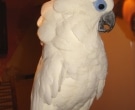Content |
|---|
Description:
50 cm. length and a weight between 500 and 580 gr.
The plumage of the Blue-eyed cockatoo (Cacatua ophthalmica) is mostly white. Its crest is yellow, large and well rounded back, leaning to the neck.
The feathers that cover the ear, the base of the neck and cheek are pale yellow. The inside of the wings and tail are slightly yellowish. The ring around the eye is blue, the iris is dark brown and gray peak.
Only you can distinguish males and females by iris.
- Sound of the Blue-eyed cockatoo.
Habitat:
Video – "Blue-eyed cockatoo" (Blue-eyed cockatoo) |
|---|
Primary forest, edges of forests and areas with sparse vegetation to 1.000 m.
It is more common in the plains than in the mountains.
They live alone, in pairs or flocks of birds 10-20. Easy to distinguish and noisy, usually. When you are flying over forests, your flight is sandwiched between glide and powerful flapping. Probably similar habits to the Sulphur-crested cockatoo, screams as she, only that stronger.
Reproduction:
There is no information about the reproduction of this species in the wild, but in captivity the female lays around 2 eggs and incubation lasts 28-30 days. The young are altricial (totally dependent on their parents for the first few weeks of life) and they remain in the nest for nine to twelve weeks being fed by both parents; later, young people, they are accompanied for a few months.
Food:
They feed mainly on seeds, fruit, in particular the figs, berries and, possibly, insects and larvae.
Distribution:
New Britain and new Ireland in the Bismarck Archipelago (Papua New Guinea).
Conservation:
Conservation status of IUCN: Vulnerable (VU)
This species has been upgraded to Vulnerable because remote sensing techniques indicate that the lowland forest, on which this species depends for nesting, It is disappearing at a notorious enough pace to cause a rapid decline in the population.
The rapid conversion of lowland rainforest to oil plantation use over the past thirty years is likely to have caused significant loss of breeding habitat..
Although it is rare in international trade, even the limited catch would be a cause for concern.
The population is estimated at at least 10.000 mature individuals.
"Blue-eyed cockatoo" in captivity:
Extremely elegant and striking. It is gaining share as a companion pet.
It mimics human speech, is very active, capable of stunts and very close to the people.
Despite his intelligence and skills, not at all a cockatoo that can be kept in an apartment.
On the one hand, due to its high energy, and secondly because of the power of their cries.
Their average lifespan is of 40 years in captivity. Surprisingly their hope for life in nature is longer, of 50 to 60 years. The life expectancy in captivity decrease may be due to inadequate attention.
Alternative names:
– Blue eyed Cockatoo, Blue-eyed cackatoo, Blue-eyed Cockatoo (ingles).
– Cacatoès à oeil bleu, Cacatoès aux yeux bleus (French).
– Brillenkakadu (German).
– Cacatua-de-olhos-azuis (Portuguese).
– Cacatúa Oftálmica (español).
scientific classification:
– Order: Psittaciformes
– Family: Cacatuidae
– Scientific name: Cacatua ophthalmica
– Citation: Sclater,PL, 1864
– Protonimo: Cacatua ophthalmica
Ophthalmic Cockatoo Images:
Sources:
– Avibase
– Photos: Wikimedia Commons, kisspanda.rajce.idnes.cz/, Gros-becs.net
– Sounds: Frank Lambert










A white cockatoo has slipped into your photos
Thank you for your notice.. I don't know what he's doing there.
A greeting.